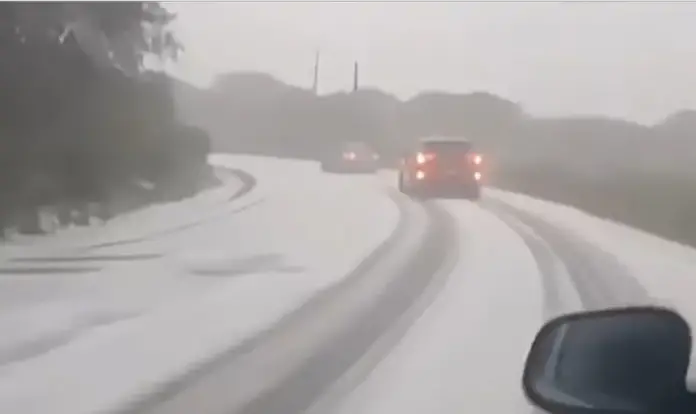On the afternoon of Saturday, July 19, a sudden hailstorm painted several areas of Guanajuato white, astonishing the population. The Sierra de Lobos was one of the places where the phenomenon was most intense.
The hail began around 1:45 p.m. in the upper reaches of the Sierra de Lobos and advanced to areas such as the Sierra de Comanja and Cuatralva, in the municipalities of San Felipe Torres Mochas and Ocampo. In some sections, such as the one from Vergel de la Sierra to the junction with Sierra de Lobos, ice completely covered the asphalt.
Poor visibility on the road caused dozens of drivers to stop their vehicles at the side of the road to avoid accidents, or to reduce their speed until conditions improved.
Hours later, the southern part of the municipality of León was also hit by a storm with hail and lightning, affecting areas such as Santa Ana del Conde, San Judas Tadeo, and the surroundings of the Fox Center.
This year’s rains have been intense and constant, something not seen in the state for several years. While they have caused severe flooding in some regions, they have also benefited the state by significantly raising dam levels, a source of relief for many.
Will the rains continue in the state of Guanajuato?
The rainy season typically begins in May and extends through September, intensifying during June, July, and August. In light of this, authorities have urged the population to stay informed and take the necessary precautions against the potential risks of these weather conditions.
The National Meteorological System, in coordination with the National Water Commission (Conagua), has predicted that rainfall will increase in the south-central states in late July and early August as a result of cyclonic activity.
Recommendations for Heavy Rainfall in Guanajuato
Given the increase in heavy rain in Guanajuato, here are some recommendations:
Avoid going out during heavy rains, especially if thunderstorms are forecast or there are active weather alerts.
Do not cross rivers, streams, or flooded streets, even if they appear shallow. Water can easily sweep away vehicles or people.
Stay informed through official channels such as Civil Protection and the National Meteorological Service.
Check and clean drains, gutters, and roofs at home to prevent water accumulation.
If you live in at-risk areas, locate temporary shelters set up by the authorities.
Source: milenio




